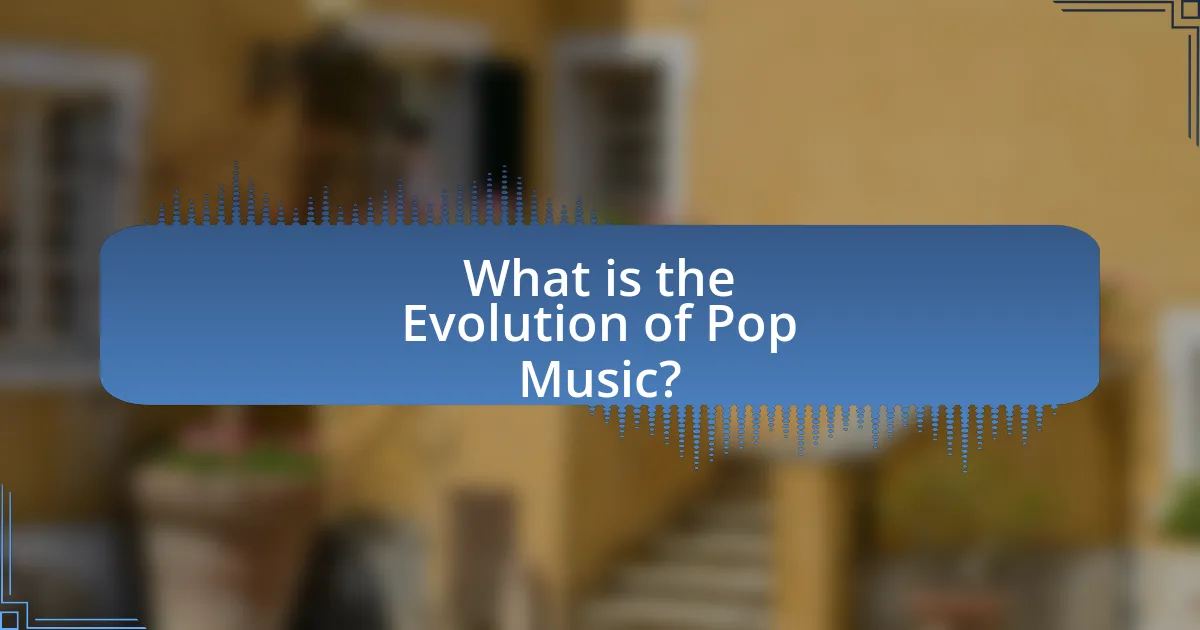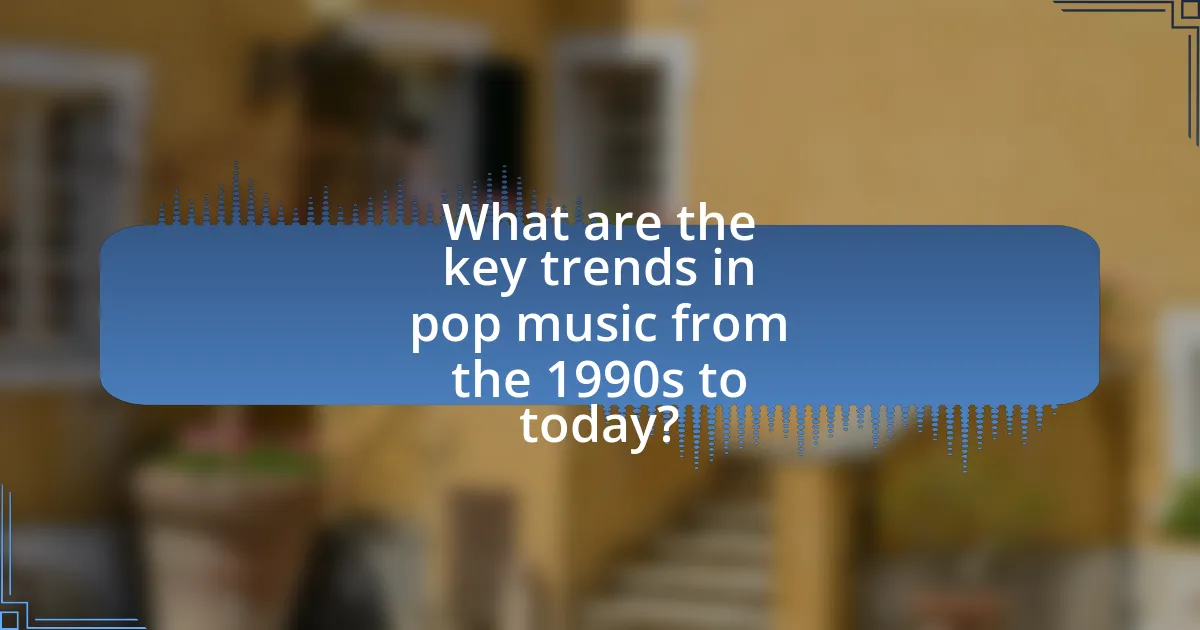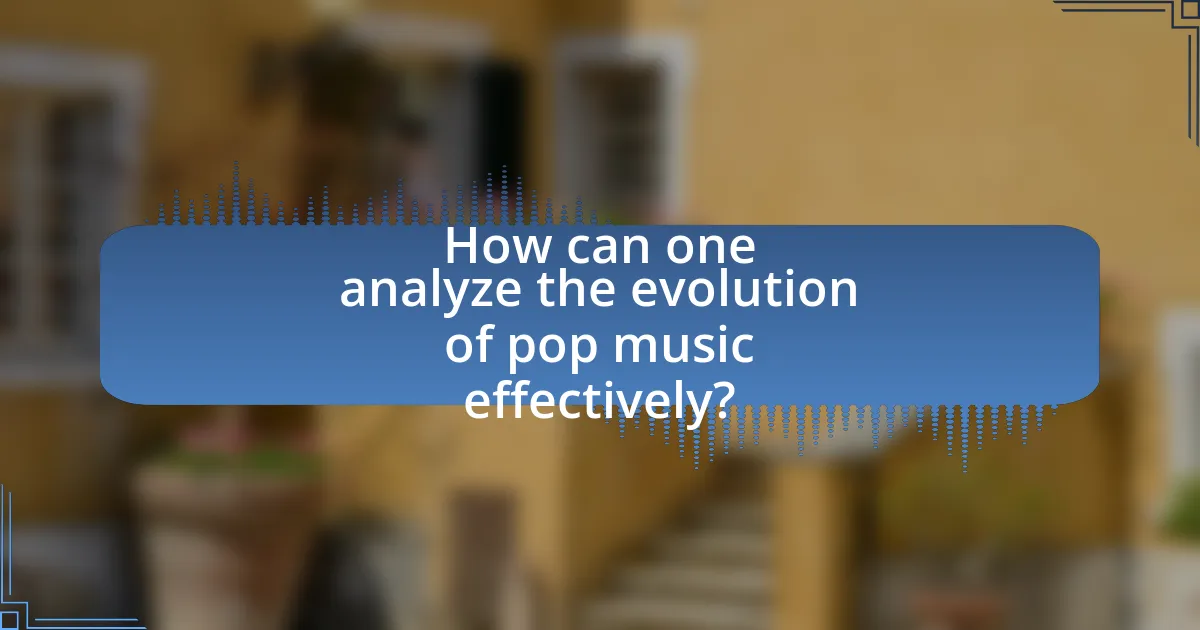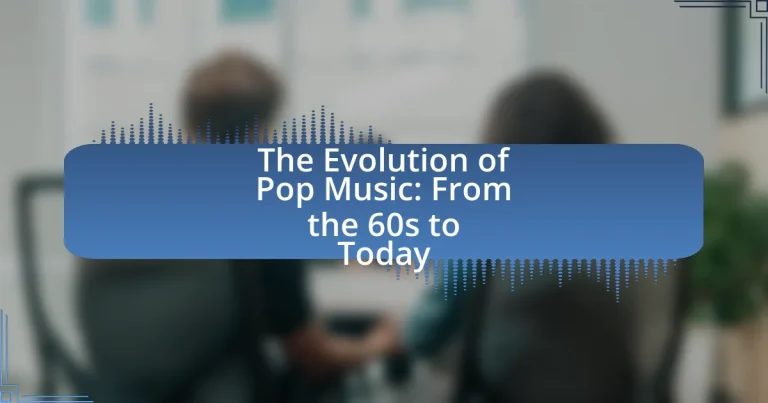The article examines the evolution of pop music from the 1960s to the present, highlighting its transformation through various musical influences and technological advancements. It begins with the emergence of pop music in the 1960s, characterized by catchy melodies and the influence of artists like The Beatles and The Supremes. The discussion progresses through the significant changes in the 1970s, including the rise of disco and the integration of new genres, followed by the impact of synthesizers and music videos in the 1980s. The article also addresses trends from the 1990s to today, focusing on the role of digital technology, social media, and streaming services in shaping contemporary pop music, as well as the challenges and issues of representation faced by artists in the current landscape.

What is the Evolution of Pop Music?
The evolution of pop music is characterized by its transformation from the early rock and roll of the 1950s and 1960s to the diverse genres and styles present today. Initially, pop music emerged as a blend of various musical influences, including jazz, blues, and folk, with artists like Elvis Presley and The Beatles shaping its early sound.
In the 1970s, pop music incorporated elements of disco and funk, exemplified by artists such as Donna Summer and the Bee Gees, while the 1980s introduced synthesizers and electronic sounds, with icons like Michael Jackson and Madonna leading the way. The 1990s saw the rise of boy bands and girl groups, alongside the influence of hip-hop, with artists like Britney Spears and NSYNC dominating the charts.
Entering the 2000s and beyond, pop music has continued to evolve, embracing digital technology and social media, leading to the emergence of new artists and genres, such as K-pop and indie pop. The genre remains fluid, reflecting cultural shifts and technological advancements, with streaming services playing a significant role in shaping listener preferences and artist exposure. This ongoing evolution illustrates pop music’s adaptability and its ability to resonate with changing societal trends.
How did pop music begin in the 1960s?
Pop music began in the 1960s as a distinct genre characterized by its catchy melodies and broad appeal, emerging from the convergence of rock and roll, rhythm and blues, and folk music. The Beatles, who gained immense popularity in the early 1960s, played a pivotal role in shaping the sound and style of pop music, introducing innovative songwriting and studio techniques. Additionally, the rise of Motown Records showcased artists like Marvin Gaye and The Supremes, further popularizing the genre with its unique blend of soul and pop elements. This era marked the transition of pop music into a dominant cultural force, influencing fashion, social movements, and youth culture.
What were the defining characteristics of 1960s pop music?
The defining characteristics of 1960s pop music included catchy melodies, simple song structures, and a focus on youth culture. This era saw the rise of influential artists like The Beatles and The Beach Boys, who utilized harmonies and innovative production techniques. The incorporation of electric instruments and the blending of various genres, such as rock, folk, and Motown, further shaped the sound of 1960s pop music. Additionally, the lyrics often addressed themes of love, social change, and rebellion, reflecting the cultural shifts of the decade.
Who were the key artists and bands that shaped the 1960s pop scene?
The key artists and bands that shaped the 1960s pop scene include The Beatles, The Beach Boys, and The Supremes. The Beatles revolutionized pop music with their innovative songwriting and recording techniques, producing iconic albums like “Sgt. Pepper’s Lonely Hearts Club Band” in 1967, which is often cited as one of the greatest albums of all time. The Beach Boys contributed to the genre with their complex harmonies and production style, particularly evident in their 1966 album “Pet Sounds,” which influenced countless musicians. The Supremes, as part of Motown, brought a distinct sound to pop music with hits like “You Can’t Hurry Love,” showcasing the crossover appeal of African American artists in mainstream pop. These artists collectively defined the sound and cultural landscape of the 1960s pop scene.
What major changes occurred in pop music during the 1970s?
During the 1970s, pop music underwent significant changes characterized by the emergence of diverse genres and the integration of technology. The decade saw the rise of disco, which dominated the charts with artists like Bee Gees and Donna Summer, while rock music evolved with the introduction of glam rock and punk rock, featuring bands such as David Bowie and The Ramones. Additionally, the use of synthesizers and electronic instruments became prevalent, influencing the sound of pop music and leading to the development of new subgenres. The 1970s also marked a shift towards more personal and introspective lyrics, reflecting social and political changes of the time. These transformations laid the groundwork for the future of pop music, making the 1970s a pivotal decade in its evolution.
How did the introduction of new genres influence pop music in the 1970s?
The introduction of new genres significantly influenced pop music in the 1970s by diversifying its sound and expanding its audience. Genres such as disco, punk, and funk emerged during this decade, each bringing distinct rhythms and styles that reshaped mainstream pop. For instance, disco’s rise led to the popularity of dance-oriented tracks, exemplified by artists like the Bee Gees, whose album “Saturday Night Fever” (1977) became a cultural phenomenon, selling over 40 million copies worldwide. Additionally, punk introduced a raw, rebellious energy to pop, with bands like the Ramones and the Sex Pistols challenging conventional music norms and appealing to youth disillusionment. Funk, represented by artists like James Brown and Parliament-Funkadelic, infused pop with groovy bass lines and syncopated rhythms, influencing countless pop hits. This genre blending not only enriched the musical landscape but also reflected the social changes of the era, making pop music more inclusive and representative of diverse cultural influences.
What role did technology play in the evolution of pop music during this decade?
Technology significantly transformed pop music during this decade by enabling new production techniques and distribution methods. The rise of digital audio workstations allowed artists to create high-quality recordings from home studios, democratizing music production. Streaming platforms like Spotify and Apple Music revolutionized how listeners access music, leading to a shift in consumption patterns where singles often gained more traction than full albums. Additionally, social media platforms facilitated direct artist-to-fan engagement, allowing for viral marketing and the rapid spread of new music. These technological advancements have reshaped the landscape of pop music, influencing both its creation and consumption.
How did the 1980s transform the landscape of pop music?
The 1980s transformed the landscape of pop music by introducing synthesizers and electronic production techniques, which became defining characteristics of the genre. This era saw the rise of artists like Michael Jackson and Madonna, who utilized these technologies to create innovative sounds and visually captivating music videos, exemplified by Jackson’s “Thriller,” which became the best-selling album of all time. The decade also marked the emergence of MTV, which revolutionized music promotion and consumption, allowing visual aesthetics to play a crucial role in an artist’s success. Additionally, the blending of genres, such as pop with rock, hip-hop, and new wave, expanded the boundaries of pop music, leading to a more diverse and commercially successful industry.
What impact did music videos have on pop music in the 1980s?
Music videos significantly transformed pop music in the 1980s by enhancing the visual presentation of artists and their music, which in turn increased audience engagement and sales. The launch of MTV in 1981 revolutionized how music was consumed, as it became a primary platform for promoting songs through visually compelling narratives and performances. Artists like Michael Jackson and Madonna leveraged music videos to create iconic imagery that defined their careers and influenced pop culture. For instance, Jackson’s “Thriller” not only became a massive hit but also set a new standard for music video production, blending storytelling with choreography and special effects. This shift led to a greater emphasis on visual aesthetics in music, ultimately making music videos an essential marketing tool for pop artists throughout the decade.
Who were the iconic pop stars of the 1980s and what made them influential?
The iconic pop stars of the 1980s included Michael Jackson, Madonna, Prince, and Whitney Houston, each of whom significantly influenced the music industry and popular culture. Michael Jackson, known as the “King of Pop,” revolutionized music videos with his innovative choreography and storytelling in hits like “Thriller,” which became the best-selling album of all time. Madonna, often referred to as the “Queen of Pop,” pushed boundaries with her provocative style and themes in songs like “Like a Virgin,” influencing fashion and gender norms. Prince blended various genres, including rock, funk, and R&B, with his unique sound and flamboyant performances, exemplified in tracks like “Purple Rain.” Whitney Houston’s powerful vocal range and emotional delivery in songs such as “I Will Always Love You” set new standards for vocal performance in pop music. Collectively, these artists not only dominated the charts but also shaped the cultural landscape of the decade, leaving a lasting legacy in the evolution of pop music.

What are the key trends in pop music from the 1990s to today?
Key trends in pop music from the 1990s to today include the rise of digital production, the blending of genres, and the influence of social media on music distribution and promotion. In the 1990s, pop music saw the emergence of artists like Britney Spears and NSYNC, who utilized advanced production techniques and catchy hooks. The 2000s introduced a fusion of pop with hip-hop and R&B, exemplified by artists like Beyoncé and Justin Timberlake. Since the 2010s, platforms like Spotify and TikTok have transformed how music is consumed and promoted, leading to viral hits and the democratization of music distribution. These trends reflect the ongoing evolution of pop music in response to technological advancements and changing listener preferences.
How did pop music evolve in the 1990s?
Pop music in the 1990s evolved significantly through the integration of diverse genres and the rise of technology. The decade saw the emergence of new styles such as grunge, hip-hop, and R&B, which influenced mainstream pop. Artists like Britney Spears and Backstreet Boys popularized teen pop, while groups like Nirvana and Pearl Jam brought alternative rock to the forefront. Additionally, the advent of digital recording and the internet transformed music production and distribution, allowing for greater accessibility and the rise of independent artists. The combination of these factors led to a more eclectic and commercially successful pop music landscape, characterized by cross-genre collaborations and a focus on visual media, exemplified by the popularity of music videos on platforms like MTV.
What were the significant musical styles that emerged in the 1990s?
Significant musical styles that emerged in the 1990s include grunge, hip-hop, and techno. Grunge, characterized by its raw sound and themes of disillusionment, was popularized by bands like Nirvana and Pearl Jam. Hip-hop gained mainstream recognition with artists such as Tupac Shakur and The Notorious B.I.G., blending rhythmic vocal style with social commentary. Techno, rooted in electronic music, saw the rise of artists like Daft Punk and The Chemical Brothers, influencing dance music culture. These styles collectively shaped the musical landscape of the decade, reflecting cultural shifts and innovations in sound.
How did the rise of the internet affect the distribution of pop music?
The rise of the internet significantly transformed the distribution of pop music by enabling direct access to artists and their work, bypassing traditional gatekeepers like record labels. This shift allowed independent musicians to distribute their music globally through platforms such as Spotify, Apple Music, and YouTube, which collectively accounted for over 80% of music consumption in the U.S. by 2020. Additionally, the internet facilitated the emergence of social media, where artists could promote their music and engage with fans directly, leading to viral hits and a more democratized music landscape. This change in distribution methods has resulted in a more diverse range of pop music being accessible to audiences worldwide.
What role does social media play in the current pop music scene?
Social media plays a crucial role in the current pop music scene by serving as a primary platform for artists to promote their music, engage with fans, and build their brands. Platforms like Instagram, TikTok, and Twitter enable musicians to share content directly with their audience, facilitating real-time interaction and feedback. For instance, TikTok has become a significant driver of music discovery, with songs going viral through user-generated content, leading to increased streaming and chart success. According to a report by the Recording Industry Association of America, 75% of music listeners discover new music through social media platforms, highlighting their impact on the industry.
How do platforms like TikTok influence pop music trends today?
Platforms like TikTok significantly influence pop music trends today by enabling viral challenges and user-generated content that promote specific songs. The platform’s algorithm prioritizes catchy and engaging snippets of music, leading to rapid exposure and popularity for tracks that resonate with users. For instance, songs like “Savage Love” by Jawsh 685 and Jason Derulo gained immense popularity after being featured in TikTok dance challenges, resulting in chart-topping success. Additionally, TikTok’s ability to connect artists directly with audiences allows for real-time feedback and trend adaptation, further shaping the music landscape.
What are the implications of streaming services on pop music consumption?
Streaming services have significantly transformed pop music consumption by providing instant access to vast libraries of music, which has altered listening habits and artist exposure. The convenience of platforms like Spotify and Apple Music allows users to discover new artists and genres easily, leading to a more diverse musical landscape. According to a 2021 report by the Recording Industry Association of America, streaming accounted for 83% of the U.S. music industry’s revenue, highlighting its dominance over traditional formats like CDs and downloads. This shift has also influenced how artists release music, with many opting for singles and EPs over full albums to maintain listener engagement in a fast-paced digital environment.
What are the current challenges facing pop music artists?
Current challenges facing pop music artists include intense competition, changing consumer preferences, and the impact of digital streaming. The music industry has become saturated, with thousands of new artists emerging each year, making it difficult for individual artists to stand out. Additionally, consumer preferences are shifting towards short-form content, such as TikTok videos, which can undermine traditional album releases and longer songs. The rise of streaming platforms has also altered revenue models, leading to lower payouts for artists per stream, which complicates financial sustainability. According to a 2022 report by the Music Industry Association, artists earn an average of only $0.004 per stream, highlighting the economic challenges they face in the current landscape.
How do issues of representation and diversity manifest in today’s pop music?
Issues of representation and diversity in today’s pop music manifest through the increased visibility of artists from various racial, gender, and sexual orientation backgrounds. For instance, the rise of artists like Lil Nas X, who openly identifies as gay, and the prominence of female artists such as Lizzo and Billie Eilish, highlight a shift towards inclusivity. According to a 2021 report by the Annenberg Inclusion Initiative, women represented only 22.5% of artists in the top charts, indicating ongoing challenges in gender representation. Additionally, the Grammy Awards have faced criticism for their lack of diversity, prompting changes in nomination processes to better reflect the variety of voices in the industry. This evolution signifies a growing awareness and demand for diverse representation in pop music, influencing both the artists and the audience.
What are the economic challenges for emerging pop artists in the current market?
Emerging pop artists face significant economic challenges in the current market, primarily due to the oversaturation of the music industry and the decline in traditional revenue streams. The rise of digital platforms has made it easier for artists to distribute their music, but it has also led to intense competition, making it difficult for new artists to stand out. Additionally, streaming services often pay artists very low per-stream rates, which can hinder their ability to generate sustainable income. According to a report by the Music Industry Revenue, the average payout per stream is less than $0.005, which means artists need millions of streams to earn a livable wage. Furthermore, the costs associated with marketing, production, and touring can be prohibitively high, often requiring emerging artists to invest their own money or rely on external funding, which is not always accessible.

How can one analyze the evolution of pop music effectively?
To analyze the evolution of pop music effectively, one should examine key historical milestones, influential artists, and shifts in musical styles and technology. This approach allows for a comprehensive understanding of how pop music has transformed over decades, reflecting cultural and societal changes. For instance, the introduction of the synthesizer in the 1980s revolutionized pop sound, leading to the rise of artists like Madonna and Michael Jackson, who dominated the charts. Additionally, analyzing chart data, such as Billboard rankings, provides quantitative evidence of trends and shifts in popularity, illustrating how genres like disco, hip-hop, and electronic music have influenced pop. By combining qualitative analysis of lyrics and themes with quantitative data, one can effectively trace the trajectory of pop music from the 1960s to the present day.
What methods can be used to study the evolution of pop music?
To study the evolution of pop music, researchers can utilize methods such as historical analysis, quantitative data analysis, and cultural studies. Historical analysis involves examining the timeline of pop music’s development, including key artists, albums, and genres that have influenced its trajectory since the 1960s. Quantitative data analysis can include statistical examination of music charts, sales data, and streaming metrics to identify trends and shifts in popularity over time. Cultural studies focus on the societal and cultural contexts that shape pop music, analyzing how factors like technology, politics, and social movements impact its evolution. These methods collectively provide a comprehensive understanding of how pop music has transformed and adapted through decades.
How can historical context enhance the understanding of pop music trends?
Historical context enhances the understanding of pop music trends by providing insights into the social, political, and cultural influences that shape musical styles and themes. For example, the rise of rock and roll in the 1950s and 1960s can be linked to post-war societal changes, including the youth culture movement and the civil rights movement, which influenced artists like Elvis Presley and Chuck Berry. Additionally, the emergence of disco in the 1970s reflected the LGBTQ+ rights movement and urban nightlife, while the grunge movement of the early 1990s was a response to economic recession and disillusionment among youth. These historical contexts reveal how external factors drive musical innovation and audience reception, illustrating the interconnectedness of music and society.
What role do cultural movements play in shaping pop music?
Cultural movements significantly influence the evolution of pop music by reflecting societal values, trends, and issues. For instance, the civil rights movement in the 1960s inspired artists like Marvin Gaye and Aretha Franklin to create music that addressed social justice and equality, leading to the emergence of politically charged pop songs. Additionally, the feminist movement has shaped pop music through artists like Madonna and Beyoncé, who incorporate themes of empowerment and gender equality into their work. These movements not only inspire lyrical content but also affect musical styles and production techniques, as seen in the incorporation of diverse genres like hip-hop and electronic music, which have roots in various cultural movements. Thus, cultural movements serve as catalysts for innovation and change in pop music, making it a dynamic reflection of contemporary society.
What resources are available for further exploration of pop music evolution?
Books, documentaries, and online courses are valuable resources for further exploration of pop music evolution. Notable books include “The Pop, Rock, and Soul Reader” by David Brackett, which provides a comprehensive overview of pop music’s history and its cultural impact. Documentaries like “20 Feet from Stardom” highlight the contributions of background singers in shaping pop music. Online platforms such as Coursera offer courses like “The History of Rock Music” that delve into the evolution of pop music from the 1960s to the present, providing structured learning and expert insights. These resources collectively enhance understanding of the genre’s development and its socio-cultural influences.
Which books and documentaries provide valuable insights into pop music history?
Books such as “The Rolling Stone Encyclopedia of Rock & Roll” by Patricia Romanowski and “Pop Music: A Very Short Introduction” by John Street provide valuable insights into pop music history. These texts cover significant artists, trends, and cultural impacts from the 1960s to the present, offering a comprehensive overview of the genre’s evolution. Documentaries like “20 Feet from Stardom,” which explores the lives of backup singers, and “Sound City,” directed by Dave Grohl, highlight pivotal moments and influential figures in pop music history, showcasing the genre’s development and its cultural significance.
How can music analysis tools aid in understanding pop music’s evolution?
Music analysis tools can significantly aid in understanding pop music’s evolution by providing quantitative data on musical elements such as melody, harmony, rhythm, and lyrics. These tools enable researchers to analyze trends over decades, revealing shifts in musical styles, themes, and production techniques. For instance, studies utilizing music analysis software have shown that the complexity of chord progressions in pop music has evolved, with a notable increase in the use of non-diatonic chords since the 2000s. Additionally, lyric analysis tools can track thematic changes, illustrating how societal issues and cultural shifts influence pop music content. Such data-driven insights allow for a clearer understanding of how pop music reflects and shapes cultural trends over time.


